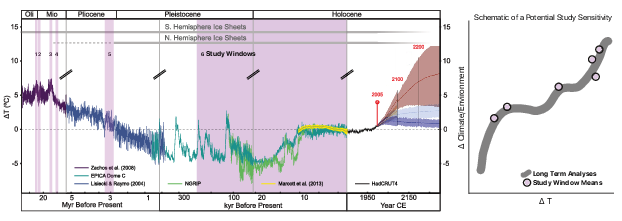Hydroclimate in the western Sahel is controlled by the West African Monsoon (WAM), bringing heavy rains to the region during the summer months. Modest changes in this system over the historical record have had outsized impacts on ecosystems and resources. Prior studies have documented the remarkable sensitivity of this system to low-latitude orbital insolation changes as well as high-latitude temperature changes throughout the Neogene. We explore the Cenozoic history of WAM hydroclimate sensitivity to orbital forcing as well as long-term, secular trends and transitions. Land surface changes, particularly the expansion of C4 grasslands, which has been dated in this region to ~10 Ma, could have a dramatic effect on tropical hydroclimate by way of various feedbacks. However, our understanding of the potential impacts on tropical monsoonal hydroclimate from major boundary regime changes is poor because we lack quantitative, high-resolution records from the tropics that span the Cenozoic.
We are measuring new orbitally resolved hydrogen isotope records from leaf waxes (δDwax) preserved in ODP Site 959 marine sediment core, located in the Gulf of Guinea. This sediment core archives ~25 myr of fairly constant sedimentation and contains distinct intervals of color and chemical oscillations that we have targeted for variability analyses. We compare these results with Plio-Pleistocene δDwax records from the same region to quantify how the monsoon responded to orbital forcings in differing global and regional boundary conditions throughout the Cenozoic. These will be the first orbitally resolved δDwax records from Africa prior to the Pliocene, and hence provide a new deeper-time perspective on hydroclimate variability in a region with uncertainty surrounding its response to future global warming.
This project is supported by NSF-OCE #2134864 awarded to Rachel Lupien.

Global temperature anomaly from 30 Ma to future warming projections adapted from Burke et al. (2018). TOTO study windows are highlighted in pink. On the right is a schematic of potential biomarker results from pink study window means and low-resolution full-core sampling cross-plotted with global temperature anomaly to demonstrate the opportunity for understanding of climate and environmental sensitivity with the proposed work.